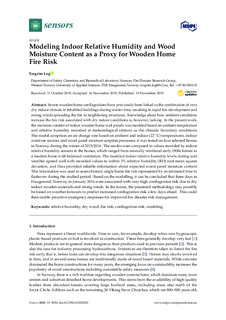| dc.contributor.author | Log, Torgrim | |
| dc.date.accessioned | 2020-01-31T13:23:16Z | |
| dc.date.available | 2020-01-31T13:23:16Z | |
| dc.date.created | 2019-11-19T18:51:33Z | |
| dc.date.issued | 2019 | |
| dc.identifier.citation | Log, T. (2019). Modeling indoor relative humidity and wood moisture content as a proxy for wooden home fire risk. Sensors, 19(22). | nb_NO |
| dc.identifier.issn | 1424-8220 | |
| dc.identifier.uri | http://hdl.handle.net/11250/2639092 | |
| dc.description.abstract | Severe wooden home conflagrations have previously been linked to the combination of very dry indoor climate in inhabited buildings during winter time, resulting in rapid fire development and strong winds spreading the fire to neighboring structures. Knowledge about how ambient conditions increase the fire risk associated with dry indoor conditions is, however, lacking. In the present work, the moisture content of indoor wooden home wall panels was modeled based on ambient temperature and relative humidity recorded at meteorological stations as the climatic boundary conditions. The model comprises an air change rate based on ambient and indoor (22 °C) temperatures, indoor moisture sources and wood panel moisture sorption processes; it was tested on four selected homes in Norway during the winter of 2015/2016. The results were compared to values recorded by indoor relative humidity sensors in the homes, which ranged from naturally ventilated early 1900s homes to a modern home with balanced ventilation. The modeled indoor relative humidity levels during cold weather agreed well with recorded values to within 3% relative humidity (RH) root mean square deviation, and thus provided reliable information about expected wood panel moisture content. This information was used to assess historic single home fire risk represented by an estimated time to flashover during the studied period. Based on the modelling, it can be concluded that three days in Haugesund, Norway, in January 2016 were associated with very high conflagration risk due to dry indoor wooden materials and strong winds. In the future, the presented methodology may possibly be based on weather forecasts to predict increased conflagration risk a few days ahead. This could then enable proactive emergency responses for improved fire disaster risk management. | nb_NO |
| dc.language.iso | eng | nb_NO |
| dc.publisher | MDPI | nb_NO |
| dc.rights | Navngivelse 4.0 Internasjonal | * |
| dc.rights.uri | http://creativecommons.org/licenses/by/4.0/deed.no | * |
| dc.subject | relative humidity | nb_NO |
| dc.subject | dry wood | nb_NO |
| dc.subject | fire risk | nb_NO |
| dc.subject | conflagration risk | nb_NO |
| dc.subject | modeling | nb_NO |
| dc.title | Modeling Indoor Relative Humidity and Wood Moisture Content as a Proxy for Wooden Home Fire Risk | nb_NO |
| dc.type | Journal article | nb_NO |
| dc.type | Peer reviewed | nb_NO |
| dc.description.version | publishedVersion | nb_NO |
| dc.rights.holder | © 2019 by the author. | nb_NO |
| dc.source.pagenumber | 22 | nb_NO |
| dc.source.volume | 19 | nb_NO |
| dc.source.journal | Sensors | nb_NO |
| dc.source.issue | 22 | nb_NO |
| dc.identifier.doi | https://doi.org/10.3390/s19225050 | |
| dc.identifier.cristin | 1749623 | |
| dc.relation.project | Norges forskningsråd: 298993 | nb_NO |
| cristin.unitcode | 203,12,13,0 | |
| cristin.unitname | Institutt for sikkerhet, kjemi- og bioingeniørfag | |
| cristin.ispublished | true | |
| cristin.fulltext | original | |
| cristin.qualitycode | 1 | |

